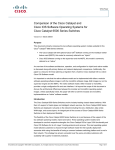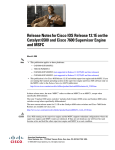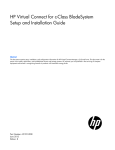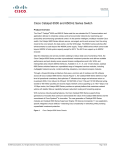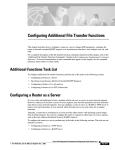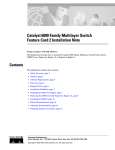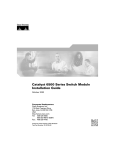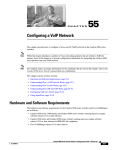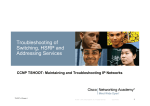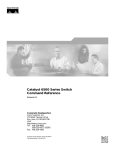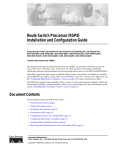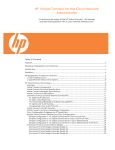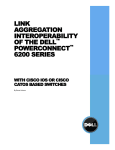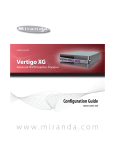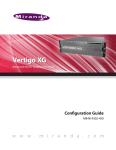Download CatOS to IOS Command convertion
Transcript
White Paper Comparison of the Cisco Catalyst and Cisco IOS Operating Systems for the Cisco Catalyst 6500 Series Switch Version 2 Introduction Purpose The proliferation of intranet and This white paper compares the two software options for the Cisco Catalyst ® 6500 Series: the Catalyst Operating System ® Internet-based applications is driving new business models such as e-commerce and (CatOS) and the Cisco IOS Software. It e-learning. Delivered via intelligent Internet discusses the software architecture, Protocol (IP) services, these applications are operation, and configuration for CatOS and transforming corporate-intranet and service the Cisco IOS Software (also known as provider infrastructures into competitive “Native” model) on Cisco Catalyst 6500 tools which offer lower business costs, Series switches. To that end, this paper is faster information flow, and scalable also an overview of the Cisco IOS Software services. In its market leadership position, on the Supervisor Engine for the Cisco Cisco Systems offers software options that Catalyst 6500 Series. enable services throughout a network This paper does not cover all the features available in the Cisco Catalyst 6500 software. It provides a review of the more frequently used Cisco Catalyst 6500 1. features for both software models Additionally, this paper is a migration guide infrastructure and give customers a choice for their specific networking needs and requirements. The Cisco Catalyst 6500 Series Switch provides two software operating modes: • Cisco CatOS on the Cisco Catalyst for readers who are familiar with CatOS 6500 Series with optional Cisco IOS and are considering using the Cisco IOS Software on the Multilayer Switching Software with their Cisco Catalyst 6500 Feature Card (MSFC) provides Layer switches. This is the second version of 2/3/4 functionality for the Cisco this document. Catalyst 6500 by integrating two operating systems. A switch running CatOS only on the Supervisor Engine is a Layer 2 forwarding device with Layer 2/3/4 functionality for Quality of 1. All features and support references are to Cisco CatOS Version 7.3.1 release and Cisco IOS Software Release 12.1(11b)EX1; there may have been caveats or general lack of support in previous releases that this document does not account for; refer to the release notes for specific details. Cisco Systems, Inc. All contents are Copyright © 1992–2002 Cisco Systems, Inc. All rights reserved. Important Notices and Privacy Statement. Page 1 of 42 Service (QoS), security, multicast, and network management of the Policy Feature Card (PFC), but does not have any routing capabilities. Layer 3 routing functionality is provided via a Cisco IOS Software image on the optional MSFC routing engine. In this paper, the combination of CatOS on the Supervisor Engine and Cisco IOS Software on the MSFC is referred to as the “hybrid” OS, meaning that two operating systems work together to provide complete Layer 2/3/4 system functionality. The hybrid model operates based on two operating images, two configurations, and two command lines; one of each for CatOS and the Cisco IOS Software. The default operation of CatOS is as a switch (all ports bridging in VLAN 1), but can be configured to operate as a router. This operating model, as a Layer 2 forwarding device, targets wiring closet or access layer services with protocols such as IEEE 802.1x, inline power, and voice virtual LAN (VLAN) identification. With the optional MSFC, the chassis is suitable for distribution or core layers of a network. • Cisco IOS Software for the Supervisor Engine on the Cisco Catalyst 6500 Series provides a single Cisco IOS image, configuration, and command line to support all Layer 2, 3, and 4 functionality on the switch. Cisco IOS has historically been a Layer 3 operating system on routing platforms; Cisco IOS on the supervisor of a Cisco Catalyst 6500 has expanded these capabilities to include true Layer 2 functionality as well. Cisco IOS requires a MSFC daughter card be present on the Supervisor Engine. In this paper, the term “Cisco IOS” refers to the Cisco IOS Software on the Supervisor Engine of the Cisco Catalyst 6500 Series. The default operation of the Cisco IOS Software is as a router (all ports are routed and shutdown), but can be configured to operate as a switch. The Cisco IOS operating mode targets service provider and enterprise data center backbones and distribution layer services. Cisco IOS Software combines the switching features of the Cisco Catalyst 6500 Series Switch with routing features of Cisco IOS Software to create a single, integrated operating system that performs all switching and routing functionality. A Cisco IOS system has the capability to scale the throughput and bandwidth of a Cisco Catalyst 6500 Series to 210 Mpps and 256 Gbps, respectively. This provides operational ease of use by allowing customers to deploy a single image across their Cisco Catalyst 6500 Series product line. Both operating models can exist simultaneously in a network environment to satisfy varying requirements. One model is recommended over another based solely on feature support, because both models are not at 100 percent feature parity. One model is not a replacement for another, because both will continue feature development. Figure 1 illustrates the two operating systems in a typical network architecture. Cisco Systems, Inc. All contents are Copyright © 1992–2002 Cisco Systems, Inc. All rights reserved. Important Notices and Privacy Statement. Page 2 of 42 Figure 1 Cisco IOS Software and Cisco Catalyst OS Positioning Access Layer Laptop Catalyst OS Cisco Catalyst 6500 with MSFC Cisco Catalyst 6500 Laptop Laptop WAN Edge ISP Cisco IOS Distribution Layer WAN Catalyst OS/ Cisco IOS Core ISP Cisco IOS Server Farm/ Data Center Cisco IOS Cisco CallManager Server Server Server Cisco IOS Server Server Server E-Commerce/Data Center Architecture Comparison The Cisco Catalyst 6500 offers a high-performance blend of Layer 2/3/4+ technology. Independent of the software model chosen, the forwarding intelligence of the system is performed in the following hardware: the Supervisor (with switch processor) baseboard, the PFC daughter card, and the MSFC (route processor) daughter card (Figure 2). Cisco Systems, Inc. All contents are Copyright © 1992–2002 Cisco Systems, Inc. All rights reserved. Important Notices and Privacy Statement. Page 3 of 42 Figure 2 Cisco Catalyst 6500 Processors MSFC Route Processor (RP) Policy Feature Card (PFC) Catalyst Supervisor Switch Processor (SP) Switch Processor Functions The Switch Processor runs a 250-Mhz R7000 CPU (Supervisor 2) and controls all chassis operations. This includes the detection of Online Insertion and Removal (OIR) events, power management, environmental management, and redundancy management. It also handles the download of the appropriate line card firmware to each line card. The Switch Processor handles basic port management (setting of port configuration, detection of link state, etc.) along with other Layer 2 functions such as Spanning Tree, VLAN Trunking Protocol (VTP), Interior Gateway Multicast Protocol (IGMP) snooping, and Dynamic Trunking Protocol (DTP). Finally, the SP provides console connection during initial system boot. Route Processor Functions The Route Processor (RP) runs a 300-Mhz R7000 CPU (MSFC2) and provides Layer 3 functions such as routing and Cisco Express Forwarding table creation. Cisco Express Forwarding is the default Layer 3 forwarding mechanism. Although the actual packet forwarding takes place in the hardware, the RP’s creation of the Cisco Express Forwarding and adjacency tables are critical. Along with the Policy Feature Card (PFC), the RP provides QoS and security functionality as well. Other functions that run on the RP include IP address resolution (ARP) and routing table maintenance. Policy Feature Card (PFC) The PFC is the application-specific integrated circuit (ASIC) forwarding complex for the system. The PFC performs the hardware-based features and services at a high performance level (tens of millions of packets per second). Features such as Layer 2 bridging, Layer 3 routing, access control, QoS marking and policing, NetFlow statistics, and multicast are implemented in the hardware of the PFC. The PFC relies on the SP and RP control plane functions for managing the hardware functionality. Software Implementation The key to Cisco IOS mode is that both CPUs (SP and RP) run the full Cisco IOS Software. There is no hidden Catalyst software running on the box and the executable images used by both CPUs run the complete IOS kernel. Both processors on Cisco IOS Software are used to improve overall system performance. Should the MSFC fail, all Layer 2/3/4 functionality is lost. The RP provides the system console connection once the system is fully operational. In contrast, CatOS operates on the SP and the PFC to provide Layer 2 forwarding and Layer 3/4 services. Should the user require Layer 3 forwarding/routing capabilities, the MSFC daughter card must be present and runs Cisco IOS Software (as part of the hybrid OS). Thus, should the MSFC fail in this model, Layer 2 functionality is not affected and remains operational. Cisco Systems, Inc. All contents are Copyright © 1992–2002 Cisco Systems, Inc. All rights reserved. Important Notices and Privacy Statement. Page 4 of 42 Software Feature Support The two software models of the Cisco Catalyst 6500 Series are not at complete feature parity. Because of this, the following table presents the CatOS and Cisco IOS Software support for some of the more commonly used protocols. However, note that many features in the Cisco IOS Software are not platform specific (like the OSPF, BGP, or PIM protocols). In these cases, the Cisco IOS features in the hybrid OS are identical to those features in the Cisco IOS Software. Additionally, Cisco IOS Software supports most of the Layer 2 CatOS functionality. Table 1 lists commonly used software features available in Cisco CatOS Version 7.3.1 and Cisco IOS Software Release 12.1(11b)EX. Table 1 Software Comparison Software Feature CatOS Cisco IOS VLAN ranges: 1000 VLANs (Layer 3 VLAN interfaces) x x Inter VLAN routing x x 4096 Layer 2 VLANs x x Private VLANs x x Dynamic VLANs x Trunking: IEEE 802.1q, ISL x x DTP, VTP x x IEEE 802.1q tunneling x x Layer 2 Protocol tunneling x x Spanning Tree: PortFast, UplinkFast, BackboneFast, BPDU Guard x x IEEE 802.1s and 802.1w x x Jumbo frames x x EtherChannel, Port Aggregation Protocol (PAgP) x x EtherChannel, IEEE 802.3ad (LACP) x x Remote Span (RSPAN) x Multicast Services: PIM, IGMP snooping, RGMP x x QoS Marking, Policing, Scheduling x x QoS ACLs x x Routing ACLs x x VLAN ACLs x x Cisco IOS Server Load Balancing x Broadcast suppression x x Protocol filtering, Cisco IOS support on Supervisor Engine 1A systems only x x Port security x Cisco Systems, Inc. All contents are Copyright © 1992–2002 Cisco Systems, Inc. All rights reserved. Important Notices and Privacy Statement. Page 5 of 42 Table 1 Software Comparison Software Feature CatOS Cisco IOS IEEE 802.1x x Cisco Discovery Protocol x x NetFlow Data Export (NDE) x x Unidirectional Link Detection (UDLD) x x Voice VLAN ID (VVID) and inline power for Cisco IP Phones x Supervisor redundancy and failover x Stateful Supervisor Switchover x x Multiprotocol Label Switching (MPLS), EoMPLS, MPLS VPN x Distributed Cisco Express Forwarding (dCEF) x Hardware and Line Card Support Table 2 is a matrix of Cisco Catalyst 6500 Series line cards with operating system support. Table 2 Hardware Modules Chassis and Supervisors CatOS Cisco IOS WS-C6513, WS-C6509, WS-C6509-NEB, WS-C6009, WS-C6506, WS-C6006, OSR-7609-AC/DC, CISCO7603, CISCO7606, WS-C6509 x x WS-X6K-S2U-MSFC2 x x WS-X6K-S2-MSFC2 x x WS-X6K-S2-PFC2 x WS-X6K-S1A-MSFC2 x x WS-X6K-SUP1A-MSFC x x WS-X6K-SUP1A-PFC x WS-X6K-SUP1A-2GE x WS-X6K-SUP1-2GE x Switching Fabrics x x WS-C6500-SFM x x WS-X6500-SFM 2 x x Ethernet Line Cards x x WS-F6K-DFC x WS-X6816-GBIC x WS-X6501-10GEX4 x Cisco Systems, Inc. All contents are Copyright © 1992–2002 Cisco Systems, Inc. All rights reserved. Important Notices and Privacy Statement. Page 6 of 42 x Table 2 Hardware Modules Chassis and Supervisors CatOS Cisco IOS WS-X6502-10GE x x WS-G6483 x x WS-G6488 x x WS-X6516-GBIC x x WS-X6516-GE-TX x x WS-X6416-GBIC x x WS-X6416-GE-MT x x WS-X6316-GE-TX x x WS-X6408A-GBIC x x WS-X6408-GBIC x x WS-X6524-100FX-MM x x WS-X6324-100FX-SM/MM x x WS-X6224-100FX-MT x x WS-X6548-RJ-21 x x WS-X6548-RJ-45 x x WS-X6348-RJ-21/V x x WS-X6348-RJ-45/V x x WS-X6148-RJ-45V x x WS-X6148-RJ21V x x WS-X6248-RJ-45 x x WS-X6248A-TEL x x WS-X6248-TEL x x WS-X6024-10FL-MT x x Voice Line Cards WS-X6624-FXS x WS-X6608-T1/E1 x Services Modules WS-X6381-IDS x x WS-X6380-NAM x x WS-X6066-SLB-APC x WS-SVC-CSG-1 x Cisco Systems, Inc. All contents are Copyright © 1992–2002 Cisco Systems, Inc. All rights reserved. Important Notices and Privacy Statement. Page 7 of 42 Table 2 Hardware Modules Chassis and Supervisors CatOS WS-SVC-NAM-1 x WS-SVC-NAM-2 x Cisco IOS Miscellaneous Modules WS-X6101-OC12-SMF/MMF x WS-X6302-MSM x WAN Modules WS-X6182-2PA x x OSM-4GE-WAN-GBIC x x OSM-2OC12-POS-MM/SI/SL x x OSM-4OC12-POS-MM/SI/SL x x OSM-4OC3-POS-SI x x OSM-8OC3-POS-MM/SI/SL x x OSM-16OC3-POS-MM/SI/SL x x OSM-1OC48-POS-SS/SI/SL x x OSM-1CHOC48/T3-SS/SI x OSM-4CHOC12/T3-MM/SI x OSM-2OC12-ATM-MM/SI x As Table 2 shows, the majority of line cards are supported in both CatOS and Cisco IOS Software. For specific software information on each line card, refer to the release notes at: http://www.cisco.com/univercd/cc/td/doc/product/lan/cat6000/relnotes/index.htm. Memory Requirements The default memory requirements are the same for both the Cisco IOS Software and the CatOS software. The Supervisor Engine 1a ships with a default of 128 MB DRAM and 16 MB bootflash. The Supervisor Engine 2 ships with a default of 128 MB DRAM (upgradable to 512 MB) and 32 MB bootflash. The MSFC2 ships with 128 MB DRAM and can be upgraded to 512 MB. The WS-X6K-S2U-MSFC2 is an orderable part number for 256 MB of DRAM on the Supervisor Engine 2 as well as 256 MB DRAM on the MSFC2. Because the Cisco IOS Software images are combined Layer 2 and 3 images, they are larger than CatOS images. Today’s Cisco IOS images are greater than 20 MB in some cases. For customer’s who want to store more than one Cisco IOS Software image for a system, the MEM-C6K-ATA-1-64M flash card, which allows up to 64 MB of storage, is available. For routing table capacity, the Cisco IOS Software has specific memory guidelines, which are documented in the release notes. Refer to the Cisco Catalyst 6500 Series release notes for these recommendations. Cisco Systems, Inc. All contents are Copyright © 1992–2002 Cisco Systems, Inc. All rights reserved. Important Notices and Privacy Statement. Page 8 of 42 Operational Comparison Image Management There are different image naming conventions for systems with hybrid operating systems and for systems with Cisco IOS Software on the Supervisor Engine. Please make sure that the correct image is chosen for given hardware. The following sections describe the different image filenames for CatOS and Cisco IOS Software. Operating System Files for the Hybrid OS In the hybrid model, two separate image files are managed by the two different operating systems. The CatOS images are stored on the Supervisor bootflash or PCMCIA flash card. The Cisco IOS image for the MSFC is stored on the MSFC bootflash. The images can be moved between the active and standby supervisors using the copy command. Images can be uploaded to the switch via the TFTP application. Cisco Catalyst 6500 systems that run hybrid use the image names listed in Table 3. Table 3 Hybrid OS Image Names Image File Description cat6000-supx CatOS image for Supervisor Engines where x is Sup1 or Sup2. Stored on the Supervisor bootflash or slot0. c6msfcx-boot-mz Layer 3 boot image where x is MSFC or MSFC2. Stored on the MSFCx bootflash: only. This image is required for running Cisco IOS Software on MSFC, recommended on MSFC2. c6msfc-is-mz c6msfc2-is-mz Layer 3 image for the MSFC or MSFC2; works with the CatOS image on the Supervisor Engine. Stored on the MSFC bootflash: or sup-slot0: The same MSFC boot helper image (c6msfc-boot) is used for the hybrid OS and Cisco IOS Software. It is stored as the first file on the MSFC bootflash. The boot helper image is a limited function system image that has network interface code and end-host protocol code. Note: The boot helper must never be erased on the MSFC(1) and should be the first image on the MSFC bootflash. The MSFC2 hardware does not require the boot image as it has more sophisticated ROMMON2 functionality; however, keeping a boot image in the MSFC bootflash is still a good practice for last resort scenarios. Operating System Files for Cisco IOS Software Cisco IOS Software requires the single image be present on a device local to the Supervisor because it is a bundled image for two processors and the SP boots first. The image can reside either on the Supervisor bootflash (sup-bootflash:) or the flash card (slot0: or disk0:); it cannot reside on the MSFC bootflash. Cisco IOS system files start with ‘c6supxy’ where x is the supervisor model number and y is the MSFC model number: 2. ROMMON is the low-level software used for fundamental hardware operation before CatOS or Cisco IOS Software take control of the system. Cisco Systems, Inc. All contents are Copyright © 1992–2002 Cisco Systems, Inc. All rights reserved. Important Notices and Privacy Statement. Page 9 of 42 Table 4 Cisco Hybrid OS Image Names Image File Description C6sup11 Bundled Layer 2–4 image for Supervisor 1, MSFC 1 C6sup12 Bundled Layer 2–4 image for Supervisor 1, MSFC 2 C6sup22 Bundled Layer 2–4 image for Supervisor 2, MSFC 2 In Cisco IOS Software, the MSFC(1) does require that the Cisco IOS boot image (c6msfc-boot-mz) is stored in the MSFC bootflash. Note: Flash card formats vary between CatOS and Cisco IOS Software thus flash cards must be formatted when switching between operating system models. In Cisco IOS Software, the storage device on the active supervisor are as follows: slot0: Active Supervisor Linear Flash Card disk0: Active Supervisor ATA Flash Card sup-bootflash: Active Supervisor 16 MB or 32 MB onboard flash bootflash: Active MSFC 16 MB MSFC onboard flash New images can be copied into the standby supervisor: flash card, RP bootflash: or SP bootflash: from active supervisor. The standby storage devices are: slaveslot0: Standby Supervisor Flash Card slavesup-bootflash: Standby Supervisor 16 MB or 32 MB onboard flash slavebootflash: Standby MSFC 16 MB onboard flash The following is an example of the command you use to copy from active supervisor flash card to standby supervisor flash: IOS# copy slot0:c6sup11-jsv-mz.121-5a.E1 slavesup-bootflash: Destination filename [c6sup11-jsv-mz.121-5a.E1]? Cisco Systems, Inc. All contents are Copyright © 1992–2002 Cisco Systems, Inc. All rights reserved. Important Notices and Privacy Statement. Page 10 of 42 Determining the Current Operating System on a Cisco Catalyst 6500 The Cisco IOS command line for both the Cisco IOS portion of hybrid and Cisco IOS systems look identical. To determine what operating system is running on the switch, you can use the show version command from the Cisco IOS command line. To access the IOS (Layer 3) functionality in hybrid OS, enter session 15 or switch console from the command line. The console is then turned over to the MSFC, and this is where both Cisco IOS and hybrid OS systems look identical. From a Hybrid System Router#show version Cisco Internetwork Operating System Software IOS (tm) MSFC2 Software (C6MSFC2-PSV-M), Version 12.1(11b)E4, EARLY DEPLOYMENT R ELEASE SOFTWARE (fc1) From a Cisco IOS System Router#show version Cisco Internetwork Operating System Software IOS (tm) c6sup2_rp Software (c6sup2_rp-PSV-M), Version 12.1(11b)EX1, EARLY DEPL YMENT RELEASE SOFTWARE (fc1) Additionally, you can determine the OS on the chassis by viewing the interfaces. For example, using show ip interface brief command on the hybrid OS shows VLANs. The same command on Cisco IOS Software displays physical interfaces (for example, gigabitethernet 1/1) as well as VLANs interfaces. Cisco IOS and Hybrid OS Boot Process The boot process in both the Cisco IOS and the hybrid operating system models is automatic and transparent to the user. In the hybrid model, the boot processes are separate for both the switch and the route processors as they each boot independent operating systems. In Cisco IOS Software, the two processors (the SP and RP) each load the Cisco IOS Software. Two processors working together yield two ROMMONs and two bootflash devices. First, the SP boots to ROMMON and loads its portion of the Cisco IOS Software. When the SP is booted, the software control is passed to the RP so that the second processor can successfully boot. From a console perspective, the RJ-45 console port on the Supervisor Engine initially shows information from the SP. During the boot cycle for the Cisco Catalyst 6500 with the Cisco IOS Software, control is passed to RP CPU as shown in the following statement on the console: Cisco Systems, Inc. All contents are Copyright © 1992–2002 Cisco Systems, Inc. All rights reserved. Important Notices and Privacy Statement. Page 11 of 42 System Bootstrap, Version 7.1(1 Copyright (c) 1994-2001 by cisco Systems, Inc. c6k_sup2 processor with 262144 Kbytes of main memory (Catalyst Supervisor ROMMON) 00:00:03: %OIR-6-CONSOLE: Changing console ownership to route processor System Bootstrap, Version 12.1(4r)E, RELEASE SOFTWARE (fc1 Copyright (c) 2000 by cisco Systems, Inc. Cat6k-MSFC2 platform with 524288 Kbytes of main memory (MSFC or RP ROMMON) After this point the Route Processor controls the system. From the software perspective, the RP acts as the primary CPU and the SP acts as the secondary CPU. Although this is transparent to the user, all configuration commands are entered directly through the Route Processor CPU in Cisco IOS Software. Commands entered that affect the SP functionality are passed internally from the RP to the SP. Unlike CatOS, net booting a Cisco IOS image from a TFTP server is not supported because the Supervisor image is a bundled image for two processors. The runtime image location (c6sup<xy>-is-mz-<version>) must be stored on a device local to the SP (sup-bootflash) or the flash card (slot0:, disk0:). Logging into the Switch Processor in Cisco IOS Software While the command line perspective is from the RP, you can log into the Switch Processor for any Layer 2-specific debugging. You can use the following commands for debugging and to check the Switch Processor status during runtime. Note that all configuration for Layer 2 thru 4 components is done on the main command line: Remote login—the remote login command (or remote login switch for the sup 2) is equivalent to the session command in CatOS. The hostname becomes the ‘hostname—sp’. Use the exit command rather than Control-C to exit the SP. Remote command—If only one command’s output is needed from the SP, use a remote command <command> (or remote command switch <command> for the Supervisor Engine 2) as seen below. Note: There is no help facility (for example, remote command show?) when using the remote command. IOS# remote command sw show bootvar IOS-sp# BOOT variable = bootflash:c6sup22-psv-mz.121-11b.EX,1 CONFIG_FILE variable = BOOTLDR variable does not exist Configuration register is 0x2002 IOS# Cisco Systems, Inc. All contents are Copyright © 1992–2002 Cisco Systems, Inc. All rights reserved. Important Notices and Privacy Statement. Page 12 of 42 Switch Management While the direct console cable connection is a useful way for managing a Cisco Catalyst 6500, other methods of network-based management (such as telnet or SNMP) require a management interface with which to access the switch. In CatOS, a single management interface, sc0, is available for the system. An IP address and VLAN are assigned to this interface. Any IP-based management of a CatOS system is then directed to the sc0 interface address. With the hybrid OS, the sc0 interface is used in conjunction with any Layer 3 VLAN interfaces created for routing functionality. CatOS> (enable) show interface sl0: flags=51<UP,POINTOPOINT,RUNNING> slip 0.0.0.0 dest 0.0.0.0 sc0: flags=63<UP,BROADCAST,RUNNING> vlan 1 inet 10.1.1.54 netmask 255.255.255.0 broadcast 10.1.1.255 In the Cisco IOS Software, the concept of a sc0 interface does not exist; however, network-based management of the switch is still possible. For every Layer 2 VLAN that is created, there can also be a corresponding Switch Virtual Interface (SVI, which is discussed further in the following section). Each SVI can have one or more IP addresses which are used for accessing the device on the particular VLAN. A SNMP or telnet client can access the device via this method. The following command displays the VLAN SVIs and the associated IP addressing for managing the system. IOS#show ip interface brief Interface IP-Address Vlan1 20.1.1.1 Vlan10 30.1.1.1 OK? Method Status YES manual up YES manual up Protocol up down Switch Configuration Configuration changes in the Catalyst software are written to NVRAM immediately after a change is made. The user does not need to manually save configuration changes to memory. All configuration in the Catalyst OS is done via a “set” command sequence. The set commands are done from the enabled-mode prompt. You can erase a particular command with a clear command from the same prompt. In contrast, Cisco IOS Software does not save configuration changes to NVRAM unless you issue the copy run start (or write memory) command. So unless the user explicitly saves the configuration, any changes to the configuration will be lost should the system be reloaded. All command line configuration in Cisco IOS (whether on the Supervisor or the MSFC) is done from the configuration mode, commonly known as “config-t”. You can remove a particular command with the no form of the original command. Port Behavior The following section details the differences in port behavior between the Catalyst software and the Cisco IOS Software. Cisco Systems, Inc. All contents are Copyright © 1992–2002 Cisco Systems, Inc. All rights reserved. Important Notices and Privacy Statement. Page 13 of 42 CatOS and Cisco IOS Software on the MSFC Before considering the Cisco IOS port concepts, a look at CatOS port concepts is used for a comparison of the two operating systems. The hybrid model offers a very tight integration of the Layer 2/4 CatOS features with the Layer 3 Cisco IOS on the MSFC features. Layer 2 ports (such as access and trunk ports) and VLANs are configured with the CatOS command set and Layer 3 VLAN interfaces are configured with the Cisco IOS Software on the MSFC command set. As ports are configured in Layer 2 VLANs with CatOS (set vlan x <slot/port>), you must create a corresponding Layer 3 SVI to enable inter-VLAN routing for the particular VLAN. You create SVIs using the interface vlan command. In the hybrid model, the MSFC operates on these logical interfaces (interface vlan 10) rather than physical interfaces (interface gig 1/1). Figure 3 illustrates these concepts and the associated commands to use Layer 2 or Layer 3 functionality. Figure 3 Port Concepts in the Hybrid Model Layer 3 Routing Route Processor interface vlan 2 ip address 10.2.1.1/24 interface vlan 3 ip address 10.3.1.1/24 interface vlan 4 ip address 10.4.1.1/24 SVI SVI SVI Layer 2 Bridging Physical Ports set vlan 2 2/1 VLAN 2 Workstation VLAN 3 Workstation Access Ports set trunk 2/4 dot1q set vlan 4 2/5 VLAN 3 Workstation VLAN 4 Switch Trunk Port Workstation Access Port Cisco IOS Software The port concepts in the Cisco IOS Software model are similar to the hybrid software model. In the Cisco IOS model, all system configuration is done from a single command-line interface; so there is no separation between the Layer 2 and Layer 3 configuration. The Layer 2 port concepts, such as access and trunk ports and Layer 3 VLAN interfaces (SVIs), still apply, although with somewhat different syntax. Cisco IOS Software offers the concept of a Layer 3 routed interface, as well. Table 6 provides an overview of the different Cisco IOS port and interface types, and a more detailed description follows. Cisco Systems, Inc. All contents are Copyright © 1992–2002 Cisco Systems, Inc. All rights reserved. Important Notices and Privacy Statement. Page 14 of 42 Interface Type Purpose Sample Configuration Routed interface Traditional IOS routing example: each port with unique network interface gigabitethernet 1/1 ip address 10.10.10.1 255.255.255.0 ipx network 1 Routed SVI Single routed interface for all of the switch ports assigned to a VLAN interface vlan 10 ip address 10.10.11.1 255.255.255.0 ipx network 2 Layer 2 VLAN Single Layer 2 broadcast domain vlan 10 Access switch port interface To group Layer 2 ports into a single VLAN interface gigabitethernet 1/1 switchport switchport mode access switchport access vlan 10 Trunk switch port interface To configure Layer 2 port belonging to different VLANs Interface Gigabit Ethernet 1/1 switch port switchport trunk encap dot1q switchport mode dynamic desirable Note: Although the terms interface and port are sometimes used interchangeably in this document, the Cisco IOS command line refers to ports as interfaces, while the CatOS command line refers to them only as ports. Figure 4 illustrates the different Cisco IOS interface types and the commands to use the Layer 2 or Layer 3 functionality. Figure 4 Port Concepts in the Cisco IOS Model interface vlan 2 ip address 10.2.1.1 255.255.255.0 interface vlan 3 ip address 10.3.1.1 255.255.255.0 interface vlan 4 ip address 10.4.1.1 255.255.255.0 Layer 3 Routing SVI Layer 2 Bridging VLAN 2 Physical interface fast2/1 Ports switchport switch mode access switchport access vlan 2 Workstation Access Switchport interface gig3/1 ip address 10.10.10.1 255.255.255.0 Route Processor SVI SVI VLAN 3 VLAN 4 interface fast2/2 switchport switchport trunk encapsulation dot1q switchport mode dynamic desirable Switch Trunk Switchport Switch Routed Interface Cisco Systems, Inc. All contents are Copyright © 1992–2002 Cisco Systems, Inc. All rights reserved. Important Notices and Privacy Statement. Page 15 of 42 Cisco IOS numbers for interfaces start from 1, not 0, for a module; that is, the first interface on the line card in slot 2 is 2/1. This is the same port numbering convention that is used with CatOS. More detailed descriptions of the three primary port types found in Cisco IOS Software are included below. Routed Interfaces Cisco IOS Software provides two means for creating Layer 3 interfaces: either at the physical port level (Routed interfaces, described here) or at the virtual port level (SVIs, described in the following section). With Cisco IOS for the Cisco Catalyst 6500, each physical port on switch arrives out of the box as a routed interface (just like any Cisco router). Every Ethernet port on the switch (whether Fast Ethernet, Gigabit Ethernet, or 10 Gigabit Ethernet) is shown as interface <interfacetype> <slot/port> and is shutdown by default. This operation differs from CatOS that has all ports enabled, Layer 2 aware, and in VLAN 1 by default. The routed interface must be configured on a unique IP subnet or IPX network. No Layer 2 protocols such as the Spanning Tree Protocol (STP) and DTP are enabled on a routed interface. CatOS does not support routed interfaces. For traditional LAN-based Ethernet ports, the routed interface does not support subinterface creation for separating dot1q encapsulations. Similar functionality to IEEE 802.1q subinterfaces is provided with trunk ports, describing in the following sections. Layer 2 VLAN To place several interfaces in the same IP or IPX subnet, the port needs to be converted from a routed interface to a Layer 2 port so that the port can be part of the Layer 2 domain or VLAN. The first step in this conversion is to create the Layer 2 VLAN entity. The VLAN ID configuration creates an instance of a Layer 2 broadcast domain or VLAN. The configuration is done from global configuration mode via a vlan <vlan #> command. VLAN IDs from 1 through 4094 are supported. VLAN IDs 1002 to 1005 are VTP default VLANs in both CatOS and Cisco IOS and are not user configurable. CatOS set vlan 8 Cisco IOS Software IOS#configure terminal IOS(config)#vlan 8 IOS(config-vlan)#exit Both the CatOS and Cisco IOS Software support the creation of 4094 Layer 2 VLANs. For a system to be able to handle 4094 VLAN, a MAC-address reduction feature must be enabled so that the system can allocate a limited number of system MAC addresses more efficiently. The following commands enable this feature. CatOS Cisco IOS Software set spantree macreduction enable IOS(config)# spanning-tree extend system-id Routed SVIs When multiple ports on the same device belong to a single subnet, a VLAN is created to isolate these ports at Layer 2 (see Layer 2 VLAN, above). Generally, these ports need to send traffic to other subnets or VLANs. This requirement is accomplished by creating an SVI to provide the inter-VLAN routing functionality. Just as in the hybrid software model, SVIs are identified as interface VLAN 1, interface VLAN 2, etc. These interfaces are associated with Layer 3 Cisco Systems, Inc. All contents are Copyright © 1992–2002 Cisco Systems, Inc. All rights reserved. Important Notices and Privacy Statement. Page 16 of 42 information such as an IP subnet or IPX network number. If a particular Layer 2 VLAN does not have an associated SVI created, then traffic will be bridged in that VLAN but not routable to or from that VLAN. As switch ports are added and removed from various VLANs, they automatically participate in the Layer 3 environment created by the appropriate SVI. For managing a device in Cisco IOS Software, the SVI requires an IP address for network reachability. Access Switchport An access switchport is a Layer 2 port that belongs to only one VLAN. For configuration, the switchport command is used to convert an interface from the default routed interface to a Layer 2 interface. In converting the port from a Layer 3 port to a Layer 2 port, Layer 2 features, including DTP and STP, are enabled. This single switchport command must be enabled before any other switch port-related configuration is allowed. Like port operation in CatOS, switchports automatically default to VLAN 1. To statically create an access port (one that will not attempt to negotiate a trunk), enter the switchport mode access command from the interface configuration. Then use the switchport access vlan <vlan-id> command to assign the access port to a particular VLAN. The following example defines port 5/1 as an access port in VLAN2. IOS# configure terminal IOS(Config)# interface fastethernet5/1 IOS(Config-if)# switchport IOS(Config-if)# switchport mode access IOS(Config-if)# switchport access vlan 2 IOS(Config-if)# no shut IOS(Config-if)# end Trunk Switchport Trunk switchports in Cisco IOS Software are Layer 2 ports that carry multiple VLANs using ISL or IEEE 802.1q encapsulations. They are fully compatible with any other device supporting the ISL or IEEE 802.1q protocols. After converting a routed interface to a Layer 2 switchport, the switchport will default to switchport mode dynamic desirable. The port is capable of forming a trunk with a neighboring Layer 2 device by using DTP for negotiating a trunk. If the neighboring interface supports trunking and is configured to allow trunking, the link becomes a Layer 2 trunk when you enter the switchport command (due to the dynamic/desirable default). By default, trunks negotiate encapsulation: if the neighboring interface supports both ISL and IEEE 802.1q encapsulation and both interfaces are set to negotiate the encapsulation type, the trunk will use ISL encapsulation. This is the same operation as in CatOS. The following example shows how to configure a trunk for IEEE 802.1q encapsulation. IOS# configure terminal IOS(Config)# interface fastethernet 5/1 IOS(Config-if)# switchport IOS(Config-if)# switchport trunk encapsulation dot1q IOS(Config-if)# end Cisco Systems, Inc. All contents are Copyright © 1992–2002 Cisco Systems, Inc. All rights reserved. Important Notices and Privacy Statement. Page 17 of 42 Refer to the Cisco IOS Configuration Guide for details on the different trunk negotiation states. http://www.cisco.com/univercd/cc/td/doc/product/lan/cat6000/12_1e/swconfig/layer2.htm Note: The recommended configuration for a dynamic trunk port would be desirable/auto between neighboring devices. The switchport trunk native vlan <vlan-id> command sets the native VLAN for an IEEE 802.1q trunk port. The allowed parameter can be used to control the VLANs that are forwarded out that interface. In addition, the pruning parameter can be used to control VTP pruning on the link. VLAN1 cannot be pruned, either in CatOS or Cisco IOS Software. Both the Cisco IOS Software and CatOS allow VLAN1 to be disabled from carrying traffic on trunks. If a no switchport command is offered, all the commands related to that switchport will no longer show in configuration and the interface type will revert to a routed interface. However, if the switchport is re-enabled, then all the previous switchport-related commands will still be reinstated. Cisco IOS Interface Configuration—Range Command All interface types—whether routed interfaces, SVIs, or switchports—can be configured in groups. This means you can apply configuration parameters to a group of ports at once. The Cisco IOS range command allows you to configure multiple interfaces at the same time by specifying interface range and then the range of ports. Without this feature, you might need to individually configure hundreds of ports in a fully populated switch. The ports in the range can be discontinuous across the same or different line cards. The following is a sample range configuration: IOS(config)#int range fa3/1 – 48,gi1/1 – 2 IOS(config-if)#switchport IOS(config-if)#switchport mode access IOS(config-if)#switchport access vlan 2 IOS(config-if)#spanning-tree portfast IOS(config-if)#no shut Note: The space before the dash is required, up to five comma-separated ranges are supported, and spaces are not required before or after the comma. The range command works for Fast Ethernet, Gigabit Ethernet, and 10 Gigabit Ethernet interfaces as seen above. It also works with VLAN interfaces if the SVIs are already created: IOS(config)#int range vlan2 - 4 IOS(config-if)# description Floor 1 access VLANs Interface Range Macros can be used to identify frequently grouped ports. A specific range of ports is defined in a macro and given a name. Once created, the macro name can be used to refer to the port grouping rather than explicitly typing in each port. This is useful when configuration changes frequently apply to the same group of ports (for example, all 10/100 server ports). This feature is not available in CatOS. Cisco Systems, Inc. All contents are Copyright © 1992–2002 Cisco Systems, Inc. All rights reserved. Important Notices and Privacy Statement. Page 18 of 42 The following example defines an interface-range macro named “servers” that corresponds to ports 3/1 through 3/8. IOS# configure terminal IOS(config)#define interface-range servers fastethernet 3/1 – 8 IOS(config)#int range macro servers IOS(config-if-range)# To display the macro: IOS# show running-config | include define define interface-range servers fastethernet 3/1 – 8 Monitoring IOS Interfaces The following commands are commonly used and available in both CatOS and Cisco IOS Software. CatOS> (enable) show port Port Name ------------------------1/1 1/2 11/1 11/2 11/2 11/4 11/5 11/6 11/7 11/8 Status ----------connected notconnect notconnect notconnect notconnect notconnect notconnect notconnect notconnect notconnect Vlan ---------1 1 1 1 1 1 1 1 1 1 Duplex ------full full auto auto auto auto auto auto auto auto Speed Type ----- -----------1000 1000BaseSX 1000 No Connector auto 10/100/1000 auto 10/100/1000 auto 10/100/1000 auto 10/100/1000 auto 10/100/1000 auto 10/100/1000 auto 10/100/1000 auto 10/100/1000 Duplex full full full full full full full full full full Speed 1000 1000 1000 1000 1000 1000 1000 1000 1000 1000 OS#show interface status Port Gi1/1 Gi1/2 Gi4/1 Gi4/2 Gi4/3 Gi4/4 Gi4/5 Gi4/6 Gi4/7 Gi4/8 Name Status notconnect notconnect connected disabled disabled disabled disabled disabled disabled disabled Vlan routed routed 1 routed routed routed routed routed routed routed Type No GBIC No GBIC 1000BaseSX 1000BaseSX No GBIC 1000BaseSX No GBIC No GBIC 1000BaseSX 1000BaseSX Cisco Systems, Inc. All contents are Copyright © 1992–2002 Cisco Systems, Inc. All rights reserved. Important Notices and Privacy Statement. Page 19 of 42 Feature Comparison The following sections describe some general feature differences between CatOS and Cisco IOS Software. This is not an exhaustive or detailed list of features and their operation, but simply a comparison between the implementation and CLI syntax of some commonly used features on the Cisco Catalyst 6500. For a more detailed feature description of all CatOS and Cisco IOS features, refer to the user documentation at: http://www.cisco.com/univercd/cc/td/doc/product/lan/cat6000/index.htm. VLAN Trunking Protocol VTP is used to manage VLAN information among switches in a Layer 2 domain. Administration is handled between VTP Servers and VTP clients so that a common VLAN topology is known throughout the network. A device can alternatively be configured as a VTP transparent device; in which case, the device will not participate in the VTP protocol but can forward VTP advertisements. The only difference in VTP functionality between CatOS and Cisco IOS Software is that CatOS allows VTP to be disabled completely (for example, the device does not forward VTP advertisements in the “off” mode). For Cisco IOS Software, VTP/VLAN configurations are performed in global configuration mode for VTP Transparent, VTP Client, and VTP Server systems3. This example compares how to define the VTP domain, mode, and VLANs and then apply them to ports: CatOS Cisco IOS Software set set set set IOS#configure terminal IOS(config)#vtp mode server IOS(config)#vtp domain ENG_CAMPUS IOS(config)#vlan 8 IOS(config-vlan)#name engineering IOS(config)#interface range fastethernet 5/1 – 48 IOS(config-if-range)#switchport IOS(config-if-range)#switchport mode access IOS(config-if-range)#switchport access vlan 8 vtp domain ENG-CAMPUS vtp mode server vlan 8 name engineering vlan 8 5/1 – 48 VTP Operation in Cisco IOS Software Configuration changes in CatOS are written to NVRAM immediately after a change is made. In contrast, the Cisco IOS Software does not save configuration changes to NVRAM unless you issue the copy run start command. VTP Client and Server systems require that VTP updates from other VTP servers be immediately saved in NVRAM without user intervention. Thus, the VTP update requirements are met by the default CatOS operation; while the Cisco IOS update model requires an alternative update operation. 3. VLAN or VTP configuration does not have to be completed in VLAN database submode. Cisco Systems, Inc. All contents are Copyright © 1992–2002 Cisco Systems, Inc. All rights reserved. Important Notices and Privacy Statement. Page 20 of 42 For this alteration, a VLAN database was introduced into Cisco IOS for the Cisco Catalyst 6500 as a method for immediately saving VTP updates for VTP Clients and Servers. This VLAN database is in the form of a separate file in NVRAM, called the vlan.dat file. This is where the VTP/VLAN information is stored for VTP Client or VTP Server systems. The entire VTP/VLAN configuration is not backed up to the Startup Config file in NVRAM when a copy run start command is issued on these systems. This does not apply to systems running as VTP transparent. VTP Transparent systems back up the entire VTP/VLAN configuration to the Startup Config file in NVRAM when you issue a copy run start command. Spanning Tree Protocol (STP) The Spanning Tree Protocol (STP) is used to prevent loops while implementing redundancy in Layer 2 environments. STP is based on one of several IEEE standards: 802.1d, 802.1s, or 802.1w. IEEE 802.1d is the original spanning-tree implementation that is based on timer mechanisms to detect and respond to network topology changes. The Cisco implementation of IEEE 802.1d in both CatOS and Cisco IOS Software is called Per-VLAN Spanning Tree Plus (PVST+). 802.1s refers to the IEEE version of Multiple Spanning Trees (MST), which allows a scalable spanning-tree implementation for environments with a large number of VLANs. IEEE 802.1w is the standard for Rapid Spanning Tree (RSTP); this protocol improves the convergence time from the original IEEE 802.1d implementation by moving from a timer-based system to a change notification-based system. This section presents the configuration differences for PVST+ (802.1d) only. Basic STP Configuration CatOS Cisco IOS Software set spantree root 10 dia 5 hello 2 set spantree root sec 11 dia 5 hello 2 set spantree priority 4096 10,11 IOS(config)# spanning-tree primary dia 5 hello 2 IOS(config)# spanning-tree sec dia 5 hello 2 IOS(config)# spanning-tree IOS(config)# spanning-tree vlan 10 root vlan 11 root vlan 10 pri 4096 vlan 11 pri 4096 PVST+ Enhancements Spanning Tree UplinkFast allows for faster convergence in a Layer 2 network after a direct root link failure. If a link from one bridge to the root bridge goes down, then the bridge will move one blocking port to forwarding immediately rather than waiting for the normal spanning tree timers to expire. This brings the convergence time from 50 seconds to 3 to 5 seconds for this type of failure. In the case of an indirect failure in a Layer 2 network, Spanning Tree BackboneFast reduces the convergence time by the “maximum age” timer value (which defaults to 20 seconds). Spanning Tree PortFast causes an access port to enter the forwarding state immediately, bypassing the listening and learning states. The feature is used on switch ports connected to a single workstation, IP Phone, server, etc. It allows these devices to connect to the network immediately, rather than waiting for spanning tree to converge. PortFast mode is supported on nontrunking access ports only because these ports typically do not transmit or receive bridge protocol data units (BPDUs) from attached devices. Cisco Systems, Inc. All contents are Copyright © 1992–2002 Cisco Systems, Inc. All rights reserved. Important Notices and Privacy Statement. Page 21 of 42 All three of these enhancements to PVST+ are supported in both CatOS and Cisco IOS Software; the configuration commands are shown here. CatOS Cisco IOS Software set spantree uplinkfast enable set spantree backbonefast enable set spantree portfast 3/1 enable IOS(config)# spanning-tree uplinkfast IOS(config)# spanning-tree backbonefast IOS(config)# int range fa3/1 IOS(config-if)# switchport IOS(config-if)# spanning-tree portfast Root and BPDU Guard Configuration The port-based BPDU Guard feature monitors to see if a BPDU is received on an unauthorized port. If a BPDU is received on an access port, spanning tree shuts down these configured interfaces, rather than putting them into the spanning-tree blocking state. Reception of a BPDU by a PortFast-configured interface signals an invalid configuration, such as the connection of an unauthorized device. The BPDU guard feature provides a secure response to invalid configurations since the interface is only re-enable manually by the administrator or automatically via the error-disable feature. The spanning-tree root guard feature forces an interface to become a designated port, and if any device accessible through the interface tries to become the root bridge, the root guard feature puts the interface into the root-inconsistent (blocked) state. Cisco IOS Software supports BPDU Guard and Root Guard feature on switchports only. The configuration dialog below shows highlights configuration differences. CatOS Cisco IOS Software set spantree bpdu-guard 3/1 enable set spanning-tree guard root 1/1 show spantree summary IOS(config)# int range fast3/1 IOS(config-if)# switchport IOS(config-if)# spanning-tree portfast bpduguard IOS(config-if)# spanning-tree guard root IOS# show spanning-tree summary EtherChannel EtherChannels in CatOS and Cisco IOS Software bundle individual Ethernet links into a single logical link that provides bandwidth aggregation and link resilience in a network. Cisco Catalyst 6500 Ethernet interfaces support up to eight interfaces per EtherChannel with all interfaces at the same speed: 10, 100, 1000, or 10,000 Mbps. EtherChannel groups can include ports on any combination of line cards. EtherChannel Operation Configuring EtherChannels in the Cisco IOS Software is a two-step process: first you assign the ports to a channel-group and then you create and configure the virtual interface port-channel. The virtual interface port-channel behaves like a physical interface. As in CatOS, all configurations on the port channel interfaces are propagated to the physical interfaces of the port channel. For example, shutting the port channel interface will shut all physical ports on that port channel. To change parameters of all ports in an EtherChannel, the configuration Cisco Systems, Inc. All contents are Copyright © 1992–2002 Cisco Systems, Inc. All rights reserved. Important Notices and Privacy Statement. Page 22 of 42 should be applied to the port channel interface. Although the Cisco IOS Software allows configuration on physical interfaces, the configuration will not be propagated to the port channel bundle. If the interfaces within the bundle are not identical, the channel will not form. CatOS Cisco IOS Software set port channel 3/1-8 1 desirable interface range gigabit 3/1 – 8 switchport channel-group 1 mode desirable no shut interface port-channel 1 switchport trunk encapsulation dot1q no shut CatOS supports a maximum of 128 EtherChannel groups and the Cisco IOS Software supports a maximum of 64 EtherChannel groups. EtherChannel Negotiation Cisco IOS and CatOS EtherChannels support both PAgP and LACP, which allows for automatic creation of port channels with other devices. PAgP is a Cisco prioprietary protocol for channel negotiation and LACP is a standard for channel negotiation (IEEE 802.3ad). The negotiation modes of both protocols are nearly identical. Note that the negotiation keywords are the same for both CatOS and Cisco IOS Software. For more detail on PAgP and LACP configuration, refer to the following configuration guides: http://www.cisco.com/univercd/cc/td/doc/product/lan/cat6000/12111bex/swcg/channel.htm http://www.cisco.com/univercd/cc/td/doc/product/lan/cat6000/sw_7_3/confg_gd/channel.htm PAgP Configuration Example: CatOS Cisco IOS Software set channelprotocol pagp set port channel 3/1-8 1 desirable interface range gigabit 3/1 – 8 switchport channel-protocol pagp channel-group 1 mode desirable interface port-channel 1 switchport trunk encapsulation dot1q no shut Cisco Systems, Inc. All contents are Copyright © 1992–2002 Cisco Systems, Inc. All rights reserved. Important Notices and Privacy Statement. Page 23 of 42 LACP Configuration Example: CatOS Cisco IOS Software set channelprotocol lacp set port channel 3/1-8 1 desirable interface range gigabit 3/1 – 8 switchport channel-protocol lacp channel-group 1 mode desirable interface port-channel 1 switchport trunk encapsulation dot1q no shut In CatOS, the channel protocol can only be configured on a per-module basis. That is, all channel ports on a particular module must use the same negotiation protocol. In the Cisco IOS Software, the channel protocol can be configured on a per-port basis. EtherChannel Load Balancing Several load-balancing algorithms are available for distributing traffic across the ports in an EtherChannel. This is regardless of the whether an EtherChannel contains Layer 2 or Layer 3 ports and interfaces. The options are the same in both CatOS and Cisco IOS Software and are shown below. CatOS set port channel all distribution ? ip Channel distribution mac Channel distribution session Channel distribution set port channel all distribution ip ? source Channel distribution destination Channel distribution both Channel distribution Cisco IOS Software ip mac session source dest both port-channel load-balance ? dst-ip Dst IP Addr dst-mac Dst Mac Addr dst-port Dst TCP/UDP Port src-dst-ip Src XOR Dst IP Addr src-dst-mac Src XOR Dst Mac Addr src-dst-port Src-Dst TCP/UDP Port src-ip Src IP Addr src-mac Src Mac Addr src-port Src TCP/UDP Port EtherChannel Types The Cisco IOS Software both Layer 2 and Layer 3 EtherChannels. In the context of the Cisco IOS Software, a Layer 2 EtherChannel includes ports that are configured as switch ports; a Layer 3 EtherChannel can include only switchport in combination with SVIs or it could include only routed interfaces. CatOS has only one type of Layer 3 EtherChannel because it does not support true routed ports, only SVIs. Cisco Systems, Inc. All contents are Copyright © 1992–2002 Cisco Systems, Inc. All rights reserved. Important Notices and Privacy Statement. Page 24 of 42 Layer 2 EtherChannels All interfaces are grouped together in a common channel-group and the subsequent interface port-channel is configured as a switchport. The channel protocol (PAgP or LACP) automatically creates the Port-Channel 1 interface when the channel-group command is enabled on the physical interface. CatOS Cisco IOS Software set port channel 3/1 – 8 1 desirable set trunk 3/1 – 8 dot1q interface range fa3/1 - 8 no shut channel-group 1 mode desirable interface port-channel 1 switchport switchport trunk encap dot1q no shut *Defaults to PAgP for negotiation Layer 3 EtherChannels with SVIs Layer 3 EtherChannels with SVIs are formed like the Layer 2 EtherChannels with the addition of a Layer 3 SVI for routing functionality. This is the method for configuring Layer 3 EtherChannels with Layer 2 VLANs providing the transport and SVIs providing the VLAN termination and routing. CatOS Cisco IOS Software Catalyst OS config: set port channel 3/1–8 2 desirable set spantree portfast 3/1-8 set vlan 10 3/1-8 interface range fa3/1 - 8 no shut channel-group 1 mode desirable interface port-channel 1 switchport switchport mode access no shut int vlan 10 ip address 10.10.10.1 255.255.255.0 MSFC config: int vlan 10 ip address 10.10.10.1 255.255.255.0 Layer 3 EtherChannels True Layer 3 EtherChannels are only specific to an IP subnet, not to a Layer 2 VLAN. As with the previously described routed interface, this is a concept only available in Cisco IOS Software. The following is an example of the command line syntax for configuring a Layer 3 EtherChannel. CatOS Cisco IOS Software No Catalyst OS equivalent int range fa3/1 – 8 channel-group 1 mode desirable interface port-channel 1 ip address 10.10.10.1 255.255.255.0 Cisco Systems, Inc. All contents are Copyright © 1992–2002 Cisco Systems, Inc. All rights reserved. Important Notices and Privacy Statement. Page 25 of 42 The following are some helpful show commands for EtherChannels on a Cisco IOS system: • show etherchannel summary to view all EtherChannels states and ports on a Cisco IOS system: cat6k #sh etherchannel summary Flags: D - down P - in port-channel I - stand-alone s – suspended R - Layer3 S - Layer2 Group Port-channel Ports -----+-------------+---------------------------------------------------------------1 Po1(SU) Fa3/13(P) Fa3/14(P) Fa3/15(P) Fa3/16(P) 2 Po2(RU) Gi4/3(P) Gi4/4(P) cat6k# • show interfaces etherchannel displays all the interfaces that have been a channel-group associated with it, regardless of their channel status. If only one interface status is needed, show interfaces <mod>/<port> etherchannel states the channel status of a specific interface without having to scroll through multiple screens of output. IOS1#sh int gi8/15 etherchannel Port state = Up Mstr In-Bndl Channel group = 2 Mode = Desirable-Sl Port-channel = Po2 GC = 0x00020001 Port index = 1 Load = 0x55 Flags: S - Device is sending Slow hello. A - Device is in Auto mode. Timers: H - Hello timer is running. S - Switching timer is running. Gcchange = 0 Pseudo port-channel = Po2 C P Q I - Device is in Consistent state. Device learns on physical port. Quit timer is running. Interface timer is running. Local information: Port Gi8/15 Flags SC State U6/S7 Partner's information: Partner Port Name Gi8/15 cat6k-3-ios Timers Hello Interval 30s Partner PAgP Count Priority 1 128 Partner Device ID 0050.808a.a200 Partner Port Gi4/3 Learning Method Any Age 11s Group Ifindex 33 Partner Flags SC Age of the port in the current state: 00h:00m:42s Cisco Systems, Inc. All contents are Copyright © 1992–2002 Cisco Systems, Inc. All rights reserved. Important Notices and Privacy Statement. Page 26 of 42 Group Cap. 20001 Access Control Lists (ACLs) Cisco Catalyst 6500 Series running Hybrid OS support the following types of ACLs: • IOS Routing ACLs (RACLs) provide access control for routed traffic between VLANs. Standard and extended IOS ACLs are configured on the input and output of router interfaces and, as such, are applied to routed packets. The use of IOS ACLs requires both a PFCx and a MSFCx on the Cisco Catalyst 6500 Series. • VLAN ACLs (VACLs) provide access control based on Layer 3 or Layer 4 information for IP or IPX protocols. A VACL is applied to all packets (bridged and routed) on a VLAN and can be configured on any VLAN interface. VACL functionality requires a PFCx. • QoS ACLs are used to identify ingress traffic which should be marked or policed upon entering a port or VLAN. QoS ACL functionality requires a PFCx. IOS RACLs have the same implementation in Hybrid as in Cisco IOS (whether on the Cisco Catalyst 6500 or any other IOS router). QoS ACLs for both operating systems are covered in the QoS section of this white paper. This section describes the differences between the VACL implementation in CatOS and Cisco IOS Software. VLAN Access Control Lists (VACLs) For CatOS, configuring a security ACL statement creates a VACL. This statement is used to configure all match and action parameters for the security policy. The VACL configuration in Cisco IOS is based on the traditional IOS ACL implementation. That is, it relies on the IOS access-list command to define the traffic matching parameters. From there, all configuration (including ACL reference and action) is done from the “vlan access-map” configuration mode. Although the Cisco IOS action is a CLI concept which is not present in CatOS, it provides similar capture, log, and redirect functionality. Refer to the user documentation for specifics on these options. The following provides a general comparison between VACL configuration between CatOS and Cisco IOS. CatOS Cisco IOS Software set vlan 10 set security acl ip sample permit ip any commit security acl sample set security acl map sample 10 vlan 10 access-list 101 permit ip any any vlan access-map sample match ip address 101 action forward vlan filter sample vlan-list 10 Note: When creating a VACL in IOS, a SVI for that VLAN interface is created. While this interface is required, it is not necessary for the interface to be configured or even in an “up” state for the VACL to operate properly. When an ACL is created, modified, or deleted, the changes exist temporarily in an edit buffer in memory. CatOS requires that the ACL be committed for it to take effect. Cisco IOS Software does not utilize the edit buffer concept. Once a policy has been built in IOS, it must then be mapped to a VLAN or interface for that ACL to take effect. Cisco Systems, Inc. All contents are Copyright © 1992–2002 Cisco Systems, Inc. All rights reserved. Important Notices and Privacy Statement. Page 27 of 42 VACL Capture The VACL Capture feature is a useful extension to VACLs. This feature is essentially a port-mirroring function based on an ACL. You can create a VACL to identify traffic that they would like to make a copy of and send to a destination port for analysis (via a network analyzer or otherwise). This does not affect the performance of the captured traffic; the original data will move through the box as it is intended. It provides a very granular tool for network troubleshooting and analysis as well as a scalable alternative to the traditional Switch Port ANalyzer (SPAN) feature. CatOS Cisco IOS Software set vlan 10 set security acl ip cap_acl permit ip any any capture commit security acl cap_acl set security acl map cap_acl 10 set security acl capture-ports 1/1 vlan 10 access-list 101 permit ip any any vlan access-map cap_acl match ip address 101 action forward capture vlan filter sample vlan-list 10 int gigabitethernet 1/1 switchport capture Quality of Service (QoS) The term “quality of service” is a superset of several different features which all work to differentiate and prioritize network traffic. These features include the classification, marking, policing, congestion avoidance, and scheduling of traffic. In the Cisco Catalyst 6500 Series, the QoS functionality resides on the PFCx (for Layer 3 marking, policing, and some classification functions) as well as on the line card (for congestion avoidance, scheduling, and some other classification functions). With the CatOS, a Supervisor without a PFC can be used for Layer 2-only QoS classification and marking. Since the PFC (as well as the MSFC) is required for Cisco IOS Software, full Layer 3 QoS capabilities are supported. As with the rest of this paper, this section is not intended to provide a general overview of QoS functionality. Instead, this section discusses configuration differences between CatOS and Cisco IOS Software for the following scenarios: • Configuring interface QoS • Configuring QoS policies By default on both operating systems, QoS is disabled. So the first step for implementing QoS features on the Cisco Catalyst 6500 is to enable QoS, as follows: CatOS Cisco IOS Software set qos enable mls qos Cisco Systems, Inc. All contents are Copyright © 1992–2002 Cisco Systems, Inc. All rights reserved. Important Notices and Privacy Statement. Page 28 of 42 Configuring Interface QoS Trust State Ports can be set to trust certain fields such as CoS, IP-precedence, or DSCP in the incoming frames. The following is a sample configuration: CatOS Cisco IOS Software set port qos 3/1 trust trust-cos interface gigabitethernet 3/1 mls qos trust cos Cisco IOS Software does not support the Extended Trust feature for differentiating IP Phone voice traffic and workstation data traffic. Default Port CoS You can set a default CoS value for all traffic entering a particular port in both operating systems. The syntax is provided here: CatOS Cisco IOS Software set port qos 3/1 cos 3 interface gigabitethernet 3/1 mls qos cos 3 Port QoS Mode QoS policies can be applied on either a port or a VLAN basis. By default, QoS functionality is port based. In this case, all QoS policies should be applied to a particular port. Policies that are applied to a VLAN will not affect traffic that is ingress on a port which is configured as port-based. If a policy is mapped to a VLAN, you must inform the interface that QoS is VLAN based for each port in the VLAN to which the VLAN policy is applicable. The mls qos vlan-based command on the intended interfaces does this, as seen below. CatOS Cisco IOS Software set port qos 3/1 vlan-based interface gigabitethernet 3/1 mls qos vlan-based CoS-to-Queue Mapping The mapping of CoS values to queues/thresholds in the standard receive and transmit queues is discussed next. In Cisco IOS, the rcv-queue keyword is used for standard receive queue configuration, the wrr-queue keyword is used for round-robin transmit queues, and the priority-queue keyword is used for priority queues. In the CatOS implementation, the CoS-to-queue mapping is configured per queue type (for example, all 1p2q2t ports will have the same configuration). In the IOS implementation, the CoS-to-queue mapping is configured per interface and the configuration changes are implemented on all ports that are managed by the same port ASIC. (ASIC to port layout Cisco Systems, Inc. All contents are Copyright © 1992–2002 Cisco Systems, Inc. All rights reserved. Important Notices and Privacy Statement. Page 29 of 42 varies by line card, but the CLI will issue a warning of the changes made.) The following example maps 802.1p value of 5 to the strict priority queue (rx and tx) and 802.1p values of 0 and 1 to the first threshold of the low priority queue. CatOS Cisco IOS Software set qos map 1p1q4t rx 2 1 cos 5 set qos map 1p2q2t tx 1 1 cos 0,1 set qos map 1p2q2t tx 3 1 cos 5 interface gigabitethernet 3/1 rcv-queue cos-map 2 1 5 wrr-queue cos-map 1 1 0 1 priority-queue cos-map 1 5 Queue Sizes The total amount of buffer per port is a fixed quantity. However, the allocation of that packet buffer per queue can be configured on most Ethernet ports. Specifically, the transmit buffer allocation can be changed on the classic Fast Ethernet, any Gigabit Ethernet, and any 10 Gigabit Ethernet line card. The receive buffer allocation is configurable on the fabric-enabled Fast Ethernet ports (6548, 6524 line cards) and on the 10 Gigabit Ethernet ports (6501, 6502 line cards). CatOS Cisco IOS Software set qos txq-ratio 1p2q2t 10 90 set qos rxq-ratio 1p1q0t 10 90 interface gigabitethernet 3/1 wrr-queue queue-limit 10 90 interface fastethernet 4/1 rcv-queue queue-limit 10 90 WRR Scheduling The Weighted Round Robin (WRR) scheduling mechanism is used to prioritize traffic as it exits an egress port. The prioritization is based on the relative weighting of each of the participating queues—so that traffic in a higher priority queue will be serviced before traffic in a low priority queue. The WRR scheduling feature is supported on the transmit queues for all Ethernet line cards. An example (for Gigabit Ethernet ports) is shown below. As with the CoS-to-queue mapping, the WRR scheduling is configured on a per-ASIC basis. CatOS Cisco IOS Software set qos wrr 1p2q2t 30 70 interface gigabitethernet 3/1 wrr-queue bandwidth 30 70 Cisco Systems, Inc. All contents are Copyright © 1992–2002 Cisco Systems, Inc. All rights reserved. Important Notices and Privacy Statement. Page 30 of 42 Configuring QoS Policies The configuration of QoS policies differs significantly between the Cisco IOS Software and CatOS. For CatOS, a QoS ACL statement is used to configure all match and action parameters for marking and policing. Cisco IOS QoS supports classification, marking, and policing using the Modular QoS CLI (MQC) syntax. A Cisco IOS policy uses traffic classes (with the class-map statement) to identify interesting traffic. These traffic classes can be defined for different types of traffic flows—for example, a user could have a different class for IP traffic, IPX traffic, and MAC traffic. Each traffic class uses IOS based access control lists and/or class match statements to identify traffic. The policy-map includes the desired action for the matched traffic (mark, police, trust, etc.). The policy defined by a policy-map is mapped to an interface using the service-policy command. Examples of both are included below. Trust with an ACL As an alternative to setting the trust state for all traffic on a port (as described above), a QoS policy can be created to trust traffic that matches a specific QoS ACL. This functionality is available in both CatOS and the Cisco IOS Software. As such, it is a straightforward example of the configuration differences between the CatOS QoS ACL syntax and the Cisco IOS MQC syntax described above. In this example, the function of using an ACL for trusting the CoS on all traffic coming into port gigabit into port gigabit 3/1 is compared. CatOS Cisco IOS Software set qos acl ip CatOS trust-cos any commit qos acl CatOS set qos acl map CatOS 3/1 access-list 101 permit ip any any policy-map IOS class IOS access-group 101 trust cos interface gigabitethernet 3/1 service-policy input IOS When a CatOS ACL is created, modified, or deleted, the changes exist temporarily in an edit buffer in memory. CatOS requires that the ACL be committed for it to take effect. Cisco IOS Software does not utilize the edit buffer concept. Once a policy has been built in IOS, it must then be mapped to either a port or a VLAN for that policy to take effect. When a policy is mapped to an “up” interface, the ASIC hardware is programmed with the necessary information and that policy is in effect. Policers The policing function is primarily used for rate limiting traffic to a configured speed. If traffic exceeds the configured speed, then it can either be dropped or marked down to a lower priority. This is useful to ensure compliance to service level agreements or for security protection. The policer can either be an aggregate or a microflow policer. An aggregate policer will rate limit all traffic in a class or group of classes to one combined (or aggregate) rate. A microflow policer will rate limit each flow (a unique SA/DA MAC address, SA/DA IP address, and TCP/UDP port numbers) in a traffic class to an individual rate. A total of 63 microflows and 1023 aggregates can be configured per chassis (independent of the operating system). Cisco Systems, Inc. All contents are Copyright © 1992–2002 Cisco Systems, Inc. All rights reserved. Important Notices and Privacy Statement. Page 31 of 42 In CatOS, the policing parameters, such as rate, burst, and related actions, are defined first in a policer statement. A QoS ACL is configured which identifies both the traffic to-be-policed and references the appropriate policer. Then, the QoS ACL needs to be committed and applied to a port or VLAN, as with normal ACL configuration. In Cisco IOS Software, the ACL is defined first. The policing parameters are defined in one of two configurations modes. This depends on the type of policer being implemented and the specific differences are discussed in the following sections. Aggregate Policers There are two forms of aggregate policers that can be defined in the Cisco IOS Software: Shared Aggregate Policers and Per-Interface Aggregate Policers. Shared Aggregate Policers (sometimes referred to as Named Aggregate Policers) are applied to a group of interfaces/ VLANs and provide the function of policing traffic across all interfaces and/or classes cumulatively. As an example, use the shared aggregate policer when a 100-Mbps rate limit should be applied to four different interfaces combined. These policers are supported in both CatOS and Cisco IOS Software. The following table shows a configuration comparison of the two implementations. CatOS Cisco IOS Software set qos policer aggregate ag1 rate 1000000 burst 32 drop set qos acl ip ag_acl trust-dscp aggregate ag1 any set qos acl map ag_acl 3/5 access-list 101 permit ip any any mls qos aggregate-policer ag1 10000000 4625 conform-action transmit exceedaction drop policy-map limit-named class class-ag1 access-group 101 police aggregate ag1 interface fastethernet 3/5 service-policy input limit-named Note: In CatOS, the rate is measured in Kbps and the burst is specified in Kb. In the Cisco IOS Software, the rate is measured in bps and the burst is specified in bytes. These differences are true for all policer types. Per-Interface Aggregate Policers are applied to an interface and traffic class, individually. These policies can be applied to multiple interfaces, but the policer polices each interface separately. As an example, use the Per Interface Aggregate policer when a 100-Mbps rate limit should be applied individually to four different interfaces. These policers are only supported in Cisco IOS Software4. 4. Similar functionality can be achieved in CatOS, but it requires configuring a unique policer for each interface in question. The Cisco IOS implementation of per-interface policers requires that the policer is defined only once, but applied separately. Cisco Systems, Inc. All contents are Copyright © 1992–2002 Cisco Systems, Inc. All rights reserved. Important Notices and Privacy Statement. Page 32 of 42 CatOS Cisco IOS Software No Catalyst OS equivalent access-list 101 permit ip any any policy-map limit-interface class class-ag1 access-group 101 police 10000000 4625 conform-action transmit exceed-action drop interface fastethernet 3/5 service-policy input limit-interface Cisco IOS Software running on the Supervisor Engine 2 supports per-port policing in a distributed forwarding system (a system with one or more Distributed Forwarding Cards present). In a distributed system, aggregate policing per-VLAN is not supported. Microflow Policers Enabling Microflow policing in the Cisco IOS Software must be done globally on the switch. This is not required in CatOS. The police flow command denotes the microflow policing configuration for the Cisco IOS Software. The rest of the configuration follows a syntax similar to configuring a Per-Interface Aggregate Policer in the Cisco IOS Software. CatOS Cisco IOS Software set qos policer microflow mf1 rate 1000000 burst 32 drop set qos acl ip mf_acl trust-dscp microflow mf1 any commit qos acl mf_acl set qos acl map mf_acl 3/5 mls qos flow-policing access-list 101 permit ip any any Policy-map limit-flow class limit-flow access-group 101 police flow 200 15 confirm-action transmit exceed-action drop interface fastethernet 3/5 service-policy input limit-flow Marking with an ACL You can set the priority fields in a frame (CoS, DSCP, or ToS) for specific traffic classes that match an ACL. This gives the user more granularity and functionality than what is provided by marking with default port CoS values. The Cisco IOS Software implementation of this feature requires a policer to achieve the desired functionality. Since it is not the intention of most marking implementations to actually rate limit traffic (as is normal with a policer), the Cisco IOS marking with a policer configuration must be done carefully. When defining the policer, ensure that you have set a rate that is as large as possible (for example, 4 Gbps) so that no traffic will be seen as out of profile. Thus, all traffic will “conform” to the policer and be marked appropriately. In addition, set both the conform and exceed action of the policer to transmit. As of Cisco IOS Software Release 12.1(11)EX, use of the set ip commands is not supported. Cisco Systems, Inc. All contents are Copyright © 1992–2002 Cisco Systems, Inc. All rights reserved. Important Notices and Privacy Statement. Page 33 of 42 The following table provides a comparison of the different configuration parameters for each operating system. CatOS Cisco IOS Software set qos acl ip CatOS dscp 24 any commit qos acl CatOS set qos acl map CatOS 3/1 access-list 101 permit ip any any policy-map IOS class IOS access-group 101 police 4000000000 conform-action set-dscptransmit 24 exceed-action transmit interface gigabitethernet 3/1 service-policy input IOS Switch Port ANalyzer (SPAN) SPAN is a troubleshooting analysis feature used to mirror the traffic coming to and from physical and logical interfaces on the switch. A SPAN session is an association of a set of SPAN source ports or VLANs that need to be monitored and a SPAN destination port is where the mirrored traffic is sent. The SPAN destination port does not belong to any VLAN and does not participate in spanning tree. Any Fast Ethernet or Gigabit Ethernet port can be configured as a SPAN source or destination port (including fabric-enabled and DFC-enabled line cards). SPAN has been implemented differently between the two operating systems. CatOS can support up to two ingress-only or ingress/egress SPAN sessions and four egress-only SPAN sessions. Cisco IOS Software supports two SPAN sessions that can include traffic from both directions on the source interfaces. Different SPAN sessions can contain overlapping or distinct sets of source interfaces. Both switchports and routed ports can be configured as SPAN sources. Different SPAN sessions must contain distinct, nonoverlapping sets of destination interfaces. Ingress SPAN (Rx) copies network traffic received by the source ports for analysis at the destination port. Egress SPAN (Tx) copies network traffic transmitted from the source ports. Configuration option “both” copies network traffic received and transmitted by the source ports to the destination port. The Cisco IOS Software can monitor only one egress port and up to 64 ingress ports as source ports. Up to 64 SPAN destination interfaces are supported. The following example configures ports 5/1-2 as SPAN Sources and port 5/3 as the SPAN destination. CatOS Cisco IOS Software set span 5/1,5/2 5/3 rx create monitor session 1 source int f5/1 – 2 rx monitor session 1 dest int f5/3 RSPAN is currently not supported in the Cisco IOS Software. Jumbo Frames The jumbo frame feature supports a single larger-than-default Ethernet MTU size (1500 bytes) on the switch. The MTU can be configured between 1500 to 10240 bytes with default (recommended) MTU of 9216 bytes. Jumbo frames are switched in hardware with no performance impact for Fast Ethernet and Gigabit Ethernet interfaces. These interfaces can be routed interfaces, access switchports, trunk switchports, or EtherChannels (observe any Cisco Systems, Inc. All contents are Copyright © 1992–2002 Cisco Systems, Inc. All rights reserved. Important Notices and Privacy Statement. Page 34 of 42 restrictions imposed by the neighboring device). Jumbo frames are supported on VLAN interfaces (SVIs), but this would only be applicable for software switched traffic. As a general rule (not OS specific), jumbo frames should be enabled on all or none of the ports in a particular VLAN. The configurations below show the jumbo frame configuration in both CatOS and Cisco IOS Software. CatOS Cisco IOS Software Set port jumbo gi1/1-2 enable Show port jumbo (to show) int range gi1/1 – 2 mtu 9216 show interface gi1/1 (to show) The above commands enable MTU 9216 bytes on the gigabit interfaces. This will automatically change the ip mtu size also. The reverse is not true. Increasing ip mtu 9216 does not increase the interface MTU size. Supervisor Redundancy Both the Cisco IOS Software and CatOS support the deployment of redundant supervisor engines for component level redundancy within a Cisco Catalyst 6500 chassis. However, the operational model for supervisor engine redundancy differs between Cisco IOS Software and CatOS. In CatOS, the foundation for supervisor redundancy is the High Availability feature. This feature allows systems with dual supervisors to synchronize the protocol states between the active and standby supervisor engines. If an active supervisor failure were to take place, the standby supervisor would then be able to take over system operation with accurate and up-to-date state information of the protocols running on the switch. This allows a supervisor failover to take place in one to three seconds and requires no network reconvergence for Layer 2, 3, and 4 protocols. From a router perspective, the MSFC engines can be configured for redundancy as well with hybrid software. For more information on hybrid High Availability, refer to the following white paper: http://www.cisco.com/warp/public/cc/pd/si/casi/ca6000/tech/hafc6_wp.pdf Cisco IOS Software on the Cisco Catalyst 6500 supports Route Processor Redundancy (RPR, also known as Enhanced High System Availability (EHSA)) and Route Processor Redundancy Plus (RPR+). In this operational model, one supervisor/MSFC pair is fully operational and the other pair is in standby mode. The show module command lists the current and standby Supervisors. There are heartbeat messages between two pairs to ensure rapid failure detection. However, the RPR and RPR+ implementations do not synchronize protocol state between the two supervisor engines. The following section provides an overview of supervisor redundancy characteristics that are equivalent between RPR and RPR+. In the Cisco IOS Software, the supervisor and MSFC are each responsible for different functions and protocols (Layer 2 vs. Layer 3). However, the system is dependent on both engines being available for proper operation. Failure of either the supervisor or the MSFC in RPR/RPR+ mode will cause a switchover from the active supervisor to the standby supervisor/MSFC. Note that in CatOS, the supervisor can remain fully operational if one MSFC fails; a MSFC failure does not necessarily cause a supervisor switchover. Cisco Systems, Inc. All contents are Copyright © 1992–2002 Cisco Systems, Inc. All rights reserved. Important Notices and Privacy Statement. Page 35 of 42 Hybrid systems with redundant supervisor/MSFC combinations can optionally have two active MSFCs in the same chassis (referred to as Dual Router Mode). In this configuration, HSRP is configured internally between both active MSFCs. With Cisco IOS Software, the standby MSFC is not fully operational. Thus, it is not possible to run internal HSRP between the two MSFCs. External HSRP from the Cisco Catalyst 6500 to other routers in the network is supported in either RPR or RPR+ mode with the Cisco IOS Software. There is no stateful protocol redundancy between supervisor engines with RPR or RPR+. The configurations are automatically synced up between active and standby supervisors in Cisco IOS Software. The following section provides an overview of supervisor redundancy characteristics that are different between RPR and RPR+. Route Processor Redundancy (RPR) With RPR enabled, the active supervisor and MSFC are operational and responsible for all packet forwarding and features. The standby supervisor and MSFC are out of reset but not all subsystems are booted. The standby supervisor is booted to the point where the gigabit uplink ports are operational, but no protocols are running on the supervisor or MSFC. Upon an active Supervisor failure, RPR detects the loss of the active supervisor and causes a switchover. The line cards are power-cycled, the supervisor and MSFC finish booting, and all Layer 2 and Layer 3 protocols are initialized. The fail-over time for the system to start forwarding traffic in EHSA is approximately 90 seconds. The actual failover time is dependent on the size and complexity of the configuration. With RPR, the startup configuration and boot variables are synchronized between the active and standby supervisor. Route Processor Redundancy Plus (RPR+) With RPR+ enabled, the active supervisor and MSFC are operational and responsible for all packet forwarding and features. The standby supervisor and MSFC are fully booted and running on standby. Since the standby supervisor is further along in the boot process, RPR+ provides a faster supervisor failover than RPR. In addition, the line card state is maintained during a supervisor failover. This helps to reduce the failover time. However, the port states are not maintained, so connections to other devices will flap. The failover time for the system to start forwarding traffic in RPR+ is approximately 30 seconds. The actual failover time is dependent on the size and complexity of the configuration. Appendix A: Cisco IOS Software and CatOS Configuration Sample Comparison This section walks you through a complete Cisco IOS mode configuration versus a CatOS configuration for a sample topology (Figure 5): Cisco Systems, Inc. All contents are Copyright © 1992–2002 Cisco Systems, Inc. All rights reserved. Important Notices and Privacy Statement. Page 36 of 42 Figure 5 Sample Network Topology for Configuration Example vlan 2 - 10.10.2.2 255.255.255.0 vlan 3 - 10.10.3.2 255.255.255.0 Layer 3 Routing SVI Route Processor 1/1 10.1.1.1 255.255.255.0 1/2 10.1.2.1 255.255.255.0 SVI Layer 2 Bridging Physical Ports Ports 2/1, 2/2, 2/3 Step 1. 802.1q Trunk 2/6 Ports 2/4, 2/5 Ports 1/1 Assign a name to the switch/router, configure prompt, time, and password. CatOS Cisco IOS Software enable set system name cat6k-switch set enablepass set ip dns domain example.com set ip dns server a.b.c.d enable configure terminal hostname cat6k-switch enable password <> ip domain-name example.com ip name-server a.b.c.d end Step 2. Configure VTP as transparent and check the status. CatOS Cisco IOS Software set vtp mode transparent show vtp domain configure terminal vtp mode transparent end write memory show vtp status Cisco Systems, Inc. All contents are Copyright © 1992–2002 Cisco Systems, Inc. All rights reserved. Important Notices and Privacy Statement. Page 37 of 42 Ports 1/2 Step 3. Create VLANs and check the status. CatOS Cisco IOS Software set vlan 2 name Marketing set vlan 3 name Finance show vlan configure terminal vlan 2 name Marketing vlan 3 name Finance end write memory show vlan Step 4. Configure the Gigabit Ethernet uplinks as routed interfaces. The Gigabit Ethernet uplinks 1/1 and 1/2 are used to connect to the remainder of the network. Because these ports only require Layer 3 routing functionality, the Cisco IOS Software can use the straightforward routed interface command structure below: CatOS Cisco IOS Software Catalyst OS config: set vlan 89 1/1 set vlan 90 1/2 configure terminal interface gigabitethernet 1/1 ip address 10.1.1.1 255.255.255.0 no shut interface gigabitethernet1/2 ip address 10.1.2.1 255.255.255.0 no shut end write memory MSFC config: int vlan 89 ip address 10.1.1.1 255.255.255.0 no shut int vlan 90 ip address 10.1.2.1 255.255.255.0 no shut end write memory [VLANs 89 and 90 are randomly chosen for this example] Cisco Systems, Inc. All contents are Copyright © 1992–2002 Cisco Systems, Inc. All rights reserved. Important Notices and Privacy Statement. Page 38 of 42 Step 5. Configure ports 2/1–3 to be used as access ports for client connections in VLAN 2, ports 2/4–5 in VLAN 3, and configure all the ports for full-duplex mode and speed 100. CatOS Cisco IOS Software set vlan 2 2/1-3 set vlan 3 2/4-5 set port speed 2/1-5 100 set port duplex 2/1-5 full show port configure terminal interface range fastethernet 2/1 - 3 switchport switchport mode access switchport access vlan 2 speed 100 duplex full interface range fastethernet 2/4 – 5 switchport switchport mode access switchport access vlan 3 speed 100 duplex full end write memory show interface status Step 6. Configure trunk switchports: port 2/6 is used to carry all three VLANs to Catalyst B, a Layer 2 Catalyst. The trunk uses IEEE 802.1q encapsulation and defaults to VLAN 1. CatOS Cisco IOS Software set trunk 2/6 dot1q set trunk 2/6 desirable interface fastethernet 2/6 switchport switchport mode dynamic desirable switchport trunk encapsulation dot1q Step 7. Optional configuration: By default, the Cisco Catalyst 6500 switch allows all VLANs on the trunk. Configure the list VLAN 50-100 to be pruned from trunk. CatOS Cisco IOS Software clear trunk 2/6 50-100 switchport trunk allowed vlan remove 50-100 Cisco Systems, Inc. All contents are Copyright © 1992–2002 Cisco Systems, Inc. All rights reserved. Important Notices and Privacy Statement. Page 39 of 42 Step 8. Configure the Routed SVI: Step 4 configured the Gigabit Ethernet interfaces as routed uplinks. This step shows the configuration for two SVI interfaces which provide routing services for both VLANs (inter-VLAN routing). This configuration uses HSRP on VLAN 2 and 3 and also includes IPX network numbers. CatOS Cisco IOS Software Routing is done on MSFC: interface vlan2 ip address 10.10.2.2 255.255.255.0 standby 1 timers 1 3 standby 1 priority 200 preempt standby 1 ip 10.10.2.6 ipx network 20 The Logical SVI interfaces are exactly the same as on MSFC. The configuration on the left can be copied. interface vlan3 ip address 10.10.3.2 255.255.255.0 standby 1 timers 1 3 standby 1 priority 200 preempt standby 1 ip 10.10.3.6 ipx network 30 Cisco Systems, Inc. All contents are Copyright © 1992–2002 Cisco Systems, Inc. All rights reserved. Important Notices and Privacy Statement. Page 40 of 42 Appendix B: CatOS and Cisco IOS Software Command Matrix CatOS Cisco IOS Software reset system Reload session remote-login Set system name Hostname Set test diaglevel Diagnostic level Set boot config-register Config-register Set boot system flash Boot system flash Set module power down/up Power enable module Set port disable Shutdown (interface mode) set port duplex Duplex set port flowcontrol send [desired | off |on] flowcontrol send [desired | off | on] set port flowcontrol receive [desired | off |on] flowcontrol receive [desired | off | on] set port negotiation <mod/port> enable/disable speed nonegotiate set port speed speed set cam mac-address-table Set port jumbo Mtu 9216 set port channel channel-group <group> mode (interface mode) set trunk (default mode is auto) switchport mode trunk (vlan database command) set udld Udld set vlan <vlan id> port 1. switchport 2. switchport mode access 3. switchport access vlan <> set vtp vtp Set spantree backbonefast Spanning-tree backbonefast Set spantree enable/disable Spanning-tree vlan Set spantree portfast Spanning-tree portfast set qos enable mls qos Set port dot1qtunnel Switchport mode dot1qtunnel show cam dynamic show mac-address-table dynamic show channel info or show port channel show etherchannel summary show mac show interface counters show port <slot/port> show interface <type slot/port> Cisco Systems, Inc. All contents are Copyright © 1992–2002 Cisco Systems, Inc. All rights reserved. Important Notices and Privacy Statement. Page 41 of 42 CatOS Cisco IOS Software show mls cef show mls cef show port show interface status Show port capabilities Show interface capabilities show span show monitor show spantree show spanning-tree show qos show mls qos show trace show debugging show trunk or show port trunk show interfaces trunk show udld show udld show vlan show vlan show vtp domain show vtp status clear cam clear mac-address-table Appendix C: Conversion Procedures Software conversion from Hybrid to Native IOS on a Cisco Catalyst 6000 Series Switch: http://www.cisco.com/warp/public/473/81.shtml Software conversion from Native IOS to Hybrid on a Cisco Catalyst 6000 Series Switch: http://www.cisco.com/warp/public/473/80.shtml Corporate Headquarters Cisco Systems, Inc. 170 West Tasman Drive San Jose, CA 95134-1706 USA www.cisco.com Tel: 408 526-4000 800 553-NETS (6387) Fax: 408 526-4100 European Headquarters Cisco Systems International BV Haarlerbergpark Haarlerbergweg 13-19 1101 CH Amsterdam The Netherlands www-europe.cisco.com Tel: 31 0 20 357 1000 Fax: 31 0 20 357 1100 Americas Headquarters Cisco Systems, Inc. 170 West Tasman Drive San Jose, CA 95134-1706 USA www.cisco.com Tel: 408 526-7660 Fax: 408 527-0883 Asia Pacific Headquarters Cisco Systems, Inc. Capital Tower 168 Robinson Road #22-01 to #29-01 Singapore 068912 www.cisco.com Tel: +65 317 7777 Fax: +65 317 7799 Cisco Systems has more than 200 offices in the following countries and regions. Addresses, phone numbers, and fax numbers are listed on the Cisco Web site at www.cisco.com/go/offices Argentina • Australia • Austria • Belgium • Brazil • Bulgaria • Canada • Chile • China PRC • Colombia • Costa Rica • Croatia Czech Republic • Denmark • Dubai, UAE • Finland • France • Germany • Greece • Hong Kong SAR • Hungary • India • Indonesia • Ireland Israel • Italy • Japan • Korea • Luxembourg • Malaysia • Mexico • The Netherlands • New Zealand • Norway • Peru • Philippines • Poland Portugal • Puerto Rico • Romania • Russia • Saudi Arabia • Scotland • Singapore • Slovakia • Slovenia • South Africa • Spain • Sweden S w i t z e r l a n d • Ta i w a n • T h a i l a n d • Tu r k e y • U k r a i n e • U n i t e d K i n g d o m • U n i t e d S t a t e s • Ve n e z u e l a • Vi e t n a m • Z i m b a b w e All contents are Copyright © 1992–2002, Cisco Systems, Inc. All rights reserved. Catalyst, Cisco, Cisco IOS, Cisco Systems, the Cisco Systems logo, and EtherChannel are registered trademarks of Cisco Systems, Inc. and/or its affiliates in the U.S. and certain other countries. All other trademarks mentioned in this document or Web site are the property of their respective owners. The use of the word partner does not imply a partnership relationship between Cisco and any other company. (0206R) LW3558 0802










































